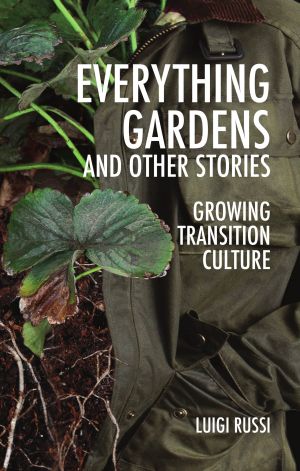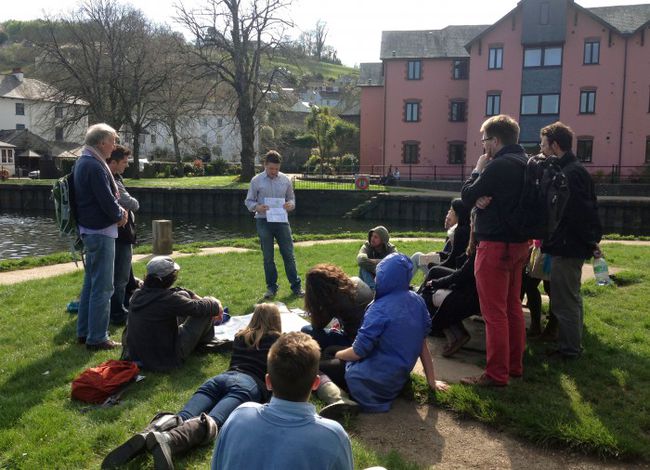27 Aug 2015
Book Review: ‘Everything Gardens’ by Luigi Russi.

Academic work on Transition can often be infuriating rather than illuminating. I was once asked to peer review a paper on Transition, a movement I was central in kickstarting and shaping, but I had to decline on the grounds that the paper was utterly incomprehensible. While some research is excellent, and offers useful insights and meaningful data, there is also much that leaves me cold, or bewildered. With this in mind, I picked up a copy of Luigi Russi’s ‘Everything Gardens and other stories: growing Transition Culture‘ with a certain trepidation.
Russi is a sociologist based at the University of Exeter, who set out to research Transition Town Totnes, not through a literature review or a few interviews, but by moving to the town, rolling his sleeves up, and getting involved. In spite of my initial reticence, I actually loved ‘Everything Gardens’, and had a few ‘aha” moments as I went through. Russi begins by questioning the usual approach that academic work on Transition tends to take, that of defining what it is (i.e. a response to peak oil and climate change etc), then to the model it proposes (still usually stuck on the 2008 model of ‘The 12 Steps’), which leads to an assessment of how well Transition is achieving its goals, how it is ‘performing’? It’s an approach that treats Transition as though it were some sort of set of policies that can be evaluated. As a result of this approach, much of the ensuing research bears little resemblance to what many Transitioners will be experiencing through their active participation in Transition.
 For Russi (right), academic research on Transition needs to be more immersive, needs to experience the “living moments through which it comes into being. And by moving with it, letting ourselves be moved as well”. For some academics, the move from the 12 Steps in The Transition Handbook (2008) to the Ingredients presented in The Transition Companion (2011) to the Support Offer (2015) is bewildering and speaks of inconsistency and uncertainty (it is an endless source of frustration to me how many academics still turn too 2008’s Handbook as the source for what Transition is). For Russi, this adaptability is just what you would expect from what he calls “a dynamic process through which Transition unfolds as a form of life”, and each formulation of it should be seen as “just passages through which this phenomenon has appeared”. Russi sees his task in immersing himself in Transition in Totnes as being “to go as deep as I can into the fine details of the phenomena of Transition”.
For Russi (right), academic research on Transition needs to be more immersive, needs to experience the “living moments through which it comes into being. And by moving with it, letting ourselves be moved as well”. For some academics, the move from the 12 Steps in The Transition Handbook (2008) to the Ingredients presented in The Transition Companion (2011) to the Support Offer (2015) is bewildering and speaks of inconsistency and uncertainty (it is an endless source of frustration to me how many academics still turn too 2008’s Handbook as the source for what Transition is). For Russi, this adaptability is just what you would expect from what he calls “a dynamic process through which Transition unfolds as a form of life”, and each formulation of it should be seen as “just passages through which this phenomenon has appeared”. Russi sees his task in immersing himself in Transition in Totnes as being “to go as deep as I can into the fine details of the phenomena of Transition”.
He argues that Transition ought not be talked about as a movement, but as a moving. It’s adaptation, its ‘multi-dimensionality’, its increasing diversification, playfulness, creativity and openness to new ideas, influences and practices, are the heart of what Transition is about, rather than the models published at different times which represent little more than snapshots representing one person’s interpretation of how it looked at that particular moment. As he puts it:
“The perception that prompts my inquiry into Transition is not so much that it can be a set of strategies to address peak oil and climate change. Instead, it is that Transition – what Transition is – moves. And this movement is what this book tries to provide an account of”.
It’s an interpretation which reminds me of one of my favourite quotes from Christopher Alexander’s seminal book ‘A Timeless Way of Building’:
“For the fact is, that this seeming chaos which is in us is a rich, rolling, swelling, dying, lilting, singing, laughing, shouting, crying, sleeping order. If we only let this order guide our acts of building, the buildings that we make, the towns we help to make, will be the forests and the meadows of the human heart”.
He then goes on to talk about his observations from participating in various strands of Transition in Totnes: food growing, Inner Transition, Transition Money and REconomy. One of his observations is that the best Transition projects are those that remove as many barriers to engagement as possible, or as he puts it when talking about the role of community gardens, they have “the capacity to involve people without asking too many questions”. “It’s a very low threshold organisation”, he writes. As he puts it:
“As a strategy for change, this involves the creation of spaces to meet people where they are, and ‘activate’ them to the possibility of developing new attachments that may shift the very position from which they develop their opinions, eliciting greater openness to the rest that Transition culture holds”.
Food growing then, for example, acts as an invitation, that in the context of Transition it can serve as a ‘facilitation tool’ to draw people into Transition from which point other ideas and experience open up for them. As he puts it, “food within Transition appears always as an open invitation to get involved in something else and something more”.
Likewise, the Totnes Pound, he suggests, provides “a different opening through which people can be approaches at the lowest point of contact: namely as consumers and users of money”. Like food, accepting the invitation to use a local currency brings with it the possibility that people “become progressively more entangled across the spectrum of Transition activities”. Just the act of calling it a Pound rather than an Acorn (the name of the LETS scheme which preceded it) is an attempt to remove barriers and unfamiliarity.
REconomy, he suggests, offers a powerful way of thinking and talking about another strand moving within Transition. Rather than it being rigidly defined what REconomy is, with a tickbox exercise that determines whether you are or aren’t, it is the ability to talk about ‘REconomy-type things’ that is where its strength is. That it enables an emergent strand in the ‘moving” or Transition to be identified. It opens up the possibility of taking a more enterprising approach, enabling different aspects of Transition to start to think about themselves more entrepreneurially.
Russi’s immersion with Inner Transition is also fascinating. He again avoids the academic impulse to try to define what Inner Transition is, stating, “I have found that questions of definition mattered little to my ability to engage effectively with it”. For him, it speaks either to the quality displayed by a person (an ‘Inner Transition-type’ of person) or by an activity (an ‘Inner Transition-type’ of activity). He argues that Inner Transition has moved from initially being a group within a Transition initiative that works with a particular set of practices, to being a thread that runs through all of the activities of a Transition group, “sometimes implicit in the life of Transition, rather than explicit”.
nner Transition, he writes, offers “facilitated spaces where conersation and conscious examination of the ‘process’ of working together, of the life of the group as a grouop, becomes possible”. In this sense, Inner Transition also plays a key role as it makes it more likely that people will feel more able to remain in and work within groups, another strand of how Transition nurtures involvement. Inner Transition, he argues, is no longer the domain of ‘Heart and Soul’ groups, but is another key identifiable strand running through the wider ‘moving’ of Transition.
He then goes on to look at what he calls ‘exemplars’, the wide diversity of practical projects emerging in Totnes. He draws attention to the stories many of them tell (‘The Nut Tree Capital of Britain’ for example), and their openness to adaptation, and to evolve and move, their “being open to further specification”. Another quality he notes in such projects is what he calls their ‘excessive quality, “in the sense that they constantly point beyond themselves, to what next questions and possibilities for action open up at every step in the process”.
He looks at what he calls the ‘insider/outsider’ dynamic, in particular the ripples generated by the successful No To Costa campaign, and how this, in the sense of Transition as a ‘moving’, helped to shape future activities to be more inclusive, more invitational, more consciously designed to reach deeper into the community. He also looks as how Transition unfolds, writing:
“[Transition] conjures a culture that offers the means to tease out that initial disquiet, developing the resources needed to get to know it better and more intimately, and to ascertain its implication for how we ought to proceed next into as many domains in which connected orientational dilemmas may present themselves to us”.
It is in the “let it go where it wants to go” spirit that Russi finds Transition most fascinating. “Transition”, he writes, “is constantly perched between innovation and drift”, and it is this that leads to Transition being what he calls a ‘living tradition’. He adds, “Transition enfolds both all that has taken place within it, as well as ‘inviting in’ determinate future possibilities”. This takes us back to his sense of Transition as not being a movement (“something completed and now frozen in the past”) but rather a ‘moving’. When we make this shift, he writes:
“we can relinquish the temptation to ask what Transition is ‘meant’ to achieve, and instead become engrossed in the process of figuring out how it ‘goes on’. From a linear, causal focus, Transition-as-moving enables instead an orientational focus; how does Transition find its way in response to the disquiets and concerns it stumbles across upon its moving. And how can we find our way within Transition, to be able to perceive it as a social phenomenon in the process of appearing before our eyes?”
What to some may appear to be tensions and contradictions within Transition for Russi speaks of “a social phenomenon that is alive and restless, as it lurches forward and subsequently reshuffles itself in response to whatever new practice has been drawn in its unfolding”.
I have only two criticisms of ‘Everything Gardens’. The first is that there are a number of moments when Russi lapses into an academic way of explaining himself that overcomplicates and infuriates, for example when he writes:
“As aids to cultural imagination, practical exemplars form knots along mobile trajectories of concerted activity … entangled in this way, they provide tautness to a matrix of material and discursive resources primed for further uptake, iin order to help cobble together what other forms Transition will be able to take in response to intervening social exigencies. Or, to restate it backwards, shared disquiets, as arresting moments of dis-orientation, elicit practical responses”.
I was left with a sense that a Plain English rewrite of this book, with more the inclusion of some photos and other elements to make it more accessible, could prove a popular addition to the more accessible literature on Transition. My scond reflection is that, as an academic analysis of Transition’s unfolding in Totnes, it is very uncritical of what it sees. Clearly from my perspective, Transition Town Totnes is a wonderful thing doing wonderful work, but having spent a lot of time here, I was surprised that beyond a couple of small points, the book wasn’t more analytical of what he saw as its failing, faults or weaknesses.
But in summary, I really enjoyed ‘Everything Gardens’. It offers a refreshingly different academic take on Transition, one that, to me, feels like it best describes Transition as I see it, as I experience it. I very much recommend it as deeply insightful addition to the literature on Transition.
You can find out more about the book here, and here is a video of Luigi himself describing the book:
